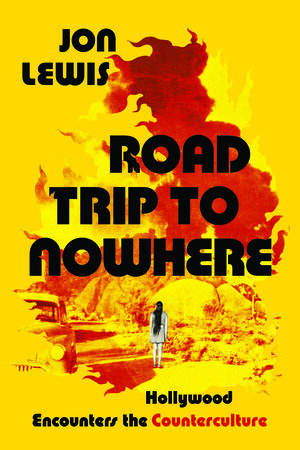The Book
Road Trip to Nowhere
The Author(s)
Jon Lewis

Jon Lewis’s Road Trip to Nowhere examines Hollywood’s encounters with the counterculture from approximately 1967 to 1976. He argues that the major studios found it difficult to market the counterculture. The Hollywood establishment initially remained committed to appealing to a mass audience and reliable business practices. As such, some of the most significant counterculture films were made overseas or produced within the B-movie industry. Lewis also highlights the perils of entertainers who enthusiastically embraced the counterculture.
The Graduate (1967), Lewis contends, demonstrated that films with counterculture overtones and themes could be enormously successful. Dustin Hoffman’s character, Benjamin, seeks to escape from conformist suburbia and a career in “plastics.” Mrs. Robinson, played by Anne Bancroft, tries to capitalize on the sexual revolution and ends up a villain in a film that exploited the generation gap. The Hollywood establishment moved cautiously, wanting to tap into an alternative youth market without alienating the silent majority. The major studios also desired to reach out to Black audiences after the success of In the Heat of Night (1967) starring Sidney Poitier. Lewis sums up the establishment’s relationship to civil rights this way: “The civil rights movement may have been much in the news, but the ever-conservative studios only ever dipped into and then quickly got out of topical, race-conscious filmmaking.”[1]
The release of Easy Rider (1969) proved a watershed moment. Harley-riding hippies Dennis Hopper and Peter Fonda became “rebel archetypes of a new and vibrant American youth culture in a very New Hollywood,” and panicked the studios.[2] Columbia and BBS Productions joined forces and released some of the era’s most memorable counterculture titles, including Five Easy Pieces (1970) and The Last Picture Show (1971). MGM threw its weight behind Michelangelo Antonioni after his Blow Up (1966) received rave reviews and two Academy Award nominations. Unfortunately for MGM and Antonioni, making Zabriskie Point (1970) was fraught with problems. Detractors focused on the director’s Communist politics, while conservative crewmembers balked at shooting a desert love-in scene. Critics panned the film. Here, Lewis reminds us that countercultural roads often went nowhere. Zabriskie Point’s two lead actors fell on hard times. Daria Halprin married Dennis Hopper, had a child, divorced, and began to find herself again after attending the Esalen Institute and taking dance therapy. In 1973, Mark Frechette and two others robbed a bank. He later died in a prison exercise room under strange circumstances.
Lewis devotes the second chapter to Christopher Jones, a rising star who resembled James Dean. In Wild in the Streets (1968), Jones plays a rock musician named Max Frost who becomes president after railing against people over the age of thirty and pointing out that young men could be drafted at eighteen, yet could not vote until reaching twenty-one. American International Pictures (AIP) followed up with 3 in the Attic (1968), also starring Jones. The plot revolves around Paxton Quigley, a playboy who maintains relationships with three women simultaneously. After he is found out, however, the women confine him to an attic and use him for sex. Quigley is portrayed as a victim of free love. But Jones faltered after appearing in Ryan’s Daughter (1970). Shaken by the deaths of Sharon Tate and Jim Morrison and the break-up of his engagement to Olivia Hussey, Jones dropped out of Hollywood.
In chapter three, Lewis explores the careers of individualistic women who risked everything to advance the causes that they held dear. Jean Seberg raised money for the Black Panthers. FBI director J. Edgar Hoover had Seberg investigated as part of the COINTELPRO program. She drifted out of the celebrity scene and died of an apparent suicide in 1979. In addition, Lewis recounts the political activism of Jane Fonda, including the infamous photo of her sitting astride a North Vietnamese antiaircraft gun in 1972. Fonda’s career, however, survived—and flourished. Moreover, the author profiles Barbara Loden and her pathbreaking movie Wanda (1970). Because the film and Loden were so countercultural, Hollywood “had no idea what to do with either of them.”[3]
Lewis closes with the Manson Family murders, which he interprets as the “nadir” of counterculture Hollywood. Charles “Tex” Watson—the most savage of the Family’s killers—maintained close relations with music industry insider Terry Melcher and Dennis Wilson of the Beach Boys. Road Trip to Nowhere is not without shortcomings. Dolores Hart, who left Hollywood to become a nun, hardly fits traditional and widely accepted definitions of the counterculture. The final chapter reads like a series of biographical sketches of the Manson Family. It lacks evidence linking Manson and his followers to Hollywood elites. Still, Lewis has succeeded in examining Hollywood’s encounters with the counterculture. It serves as an excellent starting point for both scholars and general readers interested in Hollywood and its associations with hippiedom.
[1] Jon Lewis, Road Trip to Nowhere: Hollywood Encounters the Counterculture (Berkeley: University of California Press, 2022), 16.
[2] Ibid, 42.
[3] Ibid, 223.
About the Reviewer
Damon Bach is a Senior Lecturer in the History Department at Texas A&M University. He studies modern American social, cultural, and political history. He is the author of The American Counterculture: A History of Hippies and Cultural Dissidents (Lawrence: University Press of Kansas, 2020). His current research examines post-Vietnam-era peace movements and broad dissent against American foreign policy from 1975 through 2010.

0